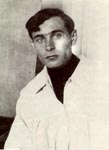Pavel Korin

Pavel Dmitriyevich Korin (July 8 [O.S. June 25] 1892 - November 22, 1967) was a Russian painter and art restorer. He is famous for his preparational work for the unimplemented painting Farewell to Rus.
The biography of Korin shows an accomplished Soviet painter and a prominent art figure, but the job he had considered the main work of his life was left unfinished. During his student years Korin was impressed by the life of Alexander Ivanov, who spent most of his adult life in creating a single painting The Appearance of Christ before the People (1835–1857). Pavel decided that he should live by Ivanov's example and devote his whole life to a single large painting. He began by preparing a very accurate, life sized copy of Ivanov's masterpiece (1920–1925). The initial name for this painting was Bless the Lord, oh my soul (Благослови, душе моя, Господа).
In 1925 Korin witnessed the intercession of Patriarch Tikhon of Moscow in the Cathedral of the Dormition of Moscow Kremlin. All people of importance in the Russian Orthodox Church, usually suppressed by the Soviets, were present. After the event Pavel decided that his magnum opus would be named Requiem, or Requiem for Russia, and would depict the intercession of Patriarch Tikhon and show the Russia that was lost after the October Revolution.
Korin feverishly painted people present at the burial service for Tikhon, often the last survivors of families of Russian nobility, or dissident priests, soon to be destroyed. Rumors about the dangerous painting soon became a matter of NKVD interest. In 1931 Maxim Gorky advised Korin that the name Requiem for Russia was too strong to be accepted and recommended a change toРусь Уходящая - literally Rus that is going away, but usually translated as Farewell to Rus. Gorky believed that the painting showing the last parade of the Orthodox Church, depicting the tragedy and at the same time the misery of those people who would will disappear into irrelevancy, would be accepted and even well received by the Government. Korin agreed with the new name of the painting.
For forty years Korin worked on the painting. He produced dozens of large (more than life size), detailed paintings that he preferred to call etudes for the Farewell to Rus masterpiece; he worked on composition. He ordered a huge canvas, designed a special stretcher for it, and spent years coating the canvas with multiple layers of the special underlays. Korin was combining the ancient methods of the icon paintings with the science of art restorations and claimed the painting prepared by his methods should survive hundreds, possibly thousands of years without the need for restoration.
In his lifetime, he had not put a single brushstroke on the canvas - forty-two years of preparational work was not enough for Pavel Korin. Though some might consider it an extreme case of procrastination, the huge canvas became a popular art exhibit in the Korin Museum. Many consider it as an art masterpiece in its own right, similar to the Black Square of Kazimir Malevich.
